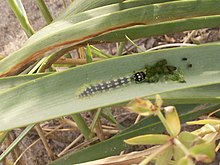Brithys crini
| Amaryllis borer | |
|---|---|

| |
| Larva | |

| |
| Adult | |
| Scientific classification | |
| Domain: | Eukaryota |
| Kingdom: | Animalia |
| Phylum: | Arthropoda |
| Class: | Insecta |
| Order: | Lepidoptera |
| Superfamily: | Noctuoidea |
| Family: | Noctuidae |
| Genus: | Brithys |
| Species: | B. crini
|
| Binomial name | |
| Brithys crini (Fabricius,1775)
| |
| Synonyms | |
| |
Brithys crini,theamaryllis borer,crinum borer,[1]lily borerorKew arches,is amothof the familyNoctuidae.It is a garden pest in parts of its range, as their larvae damage the stems and leaves of lilies, especially lilies of the familyAmaryllidaceae.[2]
Range
[edit]It is found in the coastal areas of theMediterranean,south toSouth Africa.Furthermore, it is found inJapanand inQueenslandandNorthern TerritoryinAustraliatowardsIndiaandSri Lanka.
Description
[edit]

Thewingspanof the moth is about 40 mm. Its head, thorax and forewings are very dark brown, but paler toward the wingtips. Sub-basal, median and postmedial indistinct waved lines are black. A curved submarginal ochreous line with ferrous colored lunuled found on each side of it. There is a marginal black lunule series. The hindwings are practically white.Tarsibear black and white stripes. In Europe the adults are on the wing in July.[3]
Life stages
[edit]There are several generations per year, though development slows down in cooler seasons, when the larvae sometimes overwinter by boring into the bulbs of the host plants.
The moth lays clusters of a few dozen eggs on the host plant leaves. The hatching larvae at first remain in groups and mine into the leaves. As they grow they either emerge and feed externally, or proceed down the leaves to their bases or even into the bulbs.
Thelarvaeareaposematicallycoloured in pale yellows on blacks and browns. They are unpalatable to most vertebrate predators, and also poisonous, feeding as they do, on largely unpalatable and poisonous plants. They are slightly bristly, but the bristles seem to be sensory rather than irritant. Typically they grow to about 40 mm long beforepupation.[4]
Food plants
[edit]The larvae feed on all species ofCrinum,CliviaandHippeastrum,includingCrinum angustifolium,Haemanthusspecies,Hippeastrum procerum,Pancratium maritimum,[5]Zephyranthes candida,Crocus tommasinianus,Narcissusspp., andAmaryllisbelladonna.Commonly they bore into thick leaves or even into the bulbs; Mature larvae are likely to feed externally, especially on thin-leaved plants. Heavy infestations of the caterpillars may kill plants.[6]
Predators
[edit]The most effective enemies of the larvae in Europe are thecarabid(ground beetle)Scarites bupariusand thetenebrionid(darkling beetles),Erodius siculusandPimeliabipunctata.
Control
[edit]Commercialcarbaryldusts are effective in combating the caterpillar, but they cannot reach those that have bored into the plant. The insecticide also reduces populations of predators, so that weekly applications become necessary. For small scale horticulture, or in home gardens it is better to rely on mechanical control, seeking out discoloured feeding patches on leaves and crushing the young larvae before they develop. Heavily infested leaves it often is better to cut out and destroy.[1]
References
[edit]- ^abAnnecke, D. R.; Moran, V. C. (1982).Insects and mites of cultivated plants in South Africa.London: Butterworths.ISBN0-409-08398-4.
- ^"Kew ArchesBrithys crini".UKMoths.Retrieved19 October2015.
- ^Hampson, G. F.(1894).The Fauna of British India, Including Ceylon and Burma: Moths Volume II.Taylor and Francis – via Biodiversity Heritage Library.
- ^Herbison-Evans, Don & Crossley, Stella (4 June 2018)."Brithys crini(Fabricius, 1775) Lily Borer ".Australian Caterpillars and their Butterflies and Moths.Retrieved13 January2019.
- ^"Noctuidae Noctuinae Glottulini".Moths and Butterflies of Europe and North Africa.Retrieved2 August2016.
- ^"Brithys crini,(Fabricuis, 1775) ".African Moths.Retrieved2 August2016.
